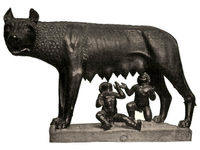|
НАЗЕДХМХБЬХЯЭ
ЮММЕЙЯХЪ
ОНЯКЕДСЧЫХИ
БШДБХМСРЮЪ
|
From founding to Empire

The ancient Etruscan bronze Capitoline Wolf
suckles the infant twins Romulus and Remus.
According to legend, the city of Rome was founded by the twins
Romulus and Remus on April 21, 753 BC, but archaeological evidence
supports the theory that Rome grew from pastoral settlements on the
Palatine Hill and in the area of the future Roman Forum,
coalescing into a city in the 8th century BC. That city
developed into the capital of the Roman Kingdom (ruled by a
succession of seven kings, according to tradition), Roman Republic
(from 510 BC, governed by the Senate), and finally the Roman Empire
(from 31 BC, ruled by an Emperor); this success depended on military
conquest, commercial predominance, as well as selective assimilation
of neighboring civilizations, most notably the Etruscans and Greeks.
Roman dominance expanded over most of Europe and the shores of the
Mediterranean sea, while its population surpassed one million
inhabitants. For almost a thousand years, Rome was the most
politically important, richest and largest city in the Western
world, and remained so after the Empire started to decline and was
split, even if it ultimately lost its capital status to Milan and
then Ravenna, and was surpassed in prestige by the Eastern capital
Constantinople.
Fall of the Empire and Middle Ages
With the rise of early Christianity, the Bishop of Rome gained
religious as well as political importance, eventually becoming known
as the Pope and establishing Rome as the centre of the Catholic
Church. After the Sack of Rome (410) by Alaric I and the fall of the
Western Roman Empire in 476 AD, Rome alternated between Byzantine
rule and plundering by Germanic barbarians. Its population declined
to a mere 20,000 during the Early Middle Ages, reducing the
sprawling city to groups of inhabited buildings interspersed among
large areas of ruins and vegetation. Rome remained nominally part of
the Byzantine Empire until 751 AD when the Lombards finally
abolished the Exarchate of Ravenna. In 756, Pepin the Short gave the
pope temporal jurisdiction over Rome and surrounding areas, thus
creating the Papal States. Rome remained the capital of the Papal
States until its annexation into the Kingdom of Italy in
1870; the city became a major pilgrimage site during the Middle Ages
and the focus of struggles between the Papacy and the Holy Roman
Empire starting with Charlemagne, who was crowned its first emperor
in Rome on Christmas 800 AD by Pope Leo III. Apart from brief
periods as an independent city during the Middle Ages, Rome kept its
status of Papal capital and "holy city" for centuries, even when the
Pope briefly relocated to Avignon (1309√1337). While no longer
politically powerful, as tragically shown by the brutal sack of
1527, the city flourished as a hub of cultural and artistic activity
during the Renaissance and the Baroque, under the patronage of the
Papal court.
17√19th century
Population rose again and reached 100,000 during
the 17th century, but Rome ultimately lagged behind the rest of the
European capitals over the subsequent centuries, being
largely busy in the Counter-Reformation process. Caught up in the
nationalistic turmoils of the 19th century and having twice gained
and lost a short-lived independence, Rome became the focus of the
hopes for Italian unification, as propelled by the Kingdom of
Italy ruled by King Vittorio Emanuele II; after the French
protection was lifted in 1870, royal troops stormed the city, and
Rome was declared capital of the newly unified Italy in 1871.
Garibaldi attacks Papal Rome in
1849
20th century
After a victorious World War I, Rome witnessed the rise to power of
Italian fascism guided by Benito Mussolini, who marched on the city
in 1922, eventually declared a new Empire and allied Italy with Nazi
Germany. This was a period of rapid growth in population, from the
212,000 people at the time of unification to more than 1,000,000,
but this trend was halted by World War II, during which Rome was
damaged by both Allied forces bombing and Nazi occupation; after the
execution of Mussolini and the end of the war, a 1946 referendum
abolished the monarchy in favor of the Italian Republic.
Rome grew
momentously after the war, as one of the driving forces behind the
"Italian economic miracle" of post-war reconstruction and
modernization. It became a fashionable city in the 1950's and early
1960's, the years of "la Dolce Vita" ("the sweet life"), and a new
rising trend in population continued till the mid-1980's, when the comune had more than 2,800,000 residents; after that, population
started to slowly decline as more residents moved to nearby comuni;
this has been attributed to their perceiving a decrease in the
quality of life,[citation needed] especially because of the
continuously jammed traffic and the worsening pollution it brings
about.
|